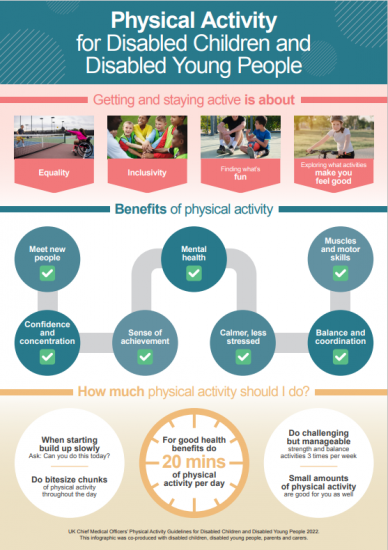
1:58 pm, Thursday, 17th February 2022
New guidelines to support disabled children to be more active
UK’s Chief Medical Officers publish first ever guidelines on physical activity for disabled children and young people.

See the infographic on the Governments website. Physical activity guidelines: disabled children and disabled young people – GOV.UK (www.gov.uk)
- New guidelines to support disabled children and young people to be more active
- Guidelines advise 20 minutes of exercise per day and strength and balance activity 3 times a week
- Supports wider work to tackle health disparities across the UK helping everyone lead healthier, happier lives
Disabled children and young people will be supported to be more physically active following the publication of new guidelines from the UK Chief Medical Officers (CMOs).
The guidance, which recommends daily levels of physical activity, will support disabled children and young people to improve their physical and mental health throughout their lives.
The guidelines are underpinned by research from Durham University, University of Bristol and Disabilities Rights UK, and the infographic they are presented in is the first of its kind to be co-produced with disabled children, young people and their families.
The new guidelines recommend disabled children and young people:
- undertake 120 to 180 minutes of aerobic physical activity per week at a moderate-to-vigorous intensity – this can be achieved in different ways (for example, 20 minutes per day or 40 minutes 3 times per week) through activities such as walking or cycling
- complete challenging, but manageable, strength and balance activities 3 times per week which are particularly beneficial for muscle strength and motor skills – for example, indoor wall climbing, yoga, and modified sports such as basketball or football
- when first starting to exercise, build up slowly to avoid injury
- break down their exercise into bite-size chunks of physical activity throughout the day to make it more manageable
The physical activity in disabled children and disabled young people evidence review and infographic are published on GOV.UK.
Read the full article on Gov.uk New guidelines to support disabled children to be more active – GOV.UK (www.gov.uk).
